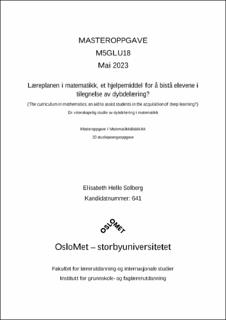| dc.description.abstract | Etter at evalueringen av kunnskapsløftet 2006 viste at mye av helklasseundervisningen som preger norske klasserom bar preg av instruksjonisme og overflatelæring ble det vurdert at ett nytt kunnskapsløfte var nødvendig. Kompetansene og ferdighetene som var ansett som nødvendige for et samfunn i stadig endring ble ansett å gå ut over det å ha overflatekunnskaper. Dybdelæring kom på agendaen, og man skulle gjennom opplæringen opparbeide seg dybdelæring, i stedet for overflatelæring, og elevene skulle i større grad være aktive deltakere i egen opplæring. Til tross for dette, og at læreplanen generelt går inn og definerer dybdelæring er det ingen operasjonalisering som påpeker hva dybdelæring innad i de enkelte fagene handler om. Mange forskere og matematikklærere påpeker at det er vanskelig å benytte læreplanen i matematikk for å fremme dybdelæring, og at læreplanen generelt legger dårlig opp til dybdelæring gjennom skolegangen. I denne masteren så ser jeg på hvordan dybdelæring kommer til uttrykk i fagfornyelsens læreplan i matematikk. Det kommer frem av analysen at læreplanen uttrykker at elevene skal lære å anvende matematikken å hensiktsmessige måter, og de skal få mulighet til både å utforske og kommunisere matematikk i norske klasserom. Dette skal bidra til at elevene i lærer å benytte sine kunnskaper og ferdigheter i flere ulike situasjoner, og at de er aktive deltakere i egen opplæring. Læreplanen legger opp til at elevene selv må reflektere, tenke kritisk og stille spørsmål, men også at de må regulere og reflektere over egen opplæring, egne strategier og tenkemåter.
After the evaluation of the Norwegian knowledge pledge of 2006 showed that much of the whole-class teaching that characterizes Norwegian classrooms was marked by instructionism and superficial learning, it was considered that a new knowledge pledge was necessary. The competences and skills that were necessary for a constantly changing society were considered to go beyond having surface knowledge. Deep learning was put on the agenda, and in-depth learning was to be built up through the school education, instead of surface learning, and students were to be active participants in their own education. Despite this, and the fact that the curriculum generally goes into and defines in-depth learning, there is no operationalization that points out what in-depth learning within the individual subjects is about. Many researchers and mathematics teachers point out that it is difficult to use the curriculum in mathematics to promote in-depth learning, and that the curriculum generally does not provide a good foundation for in-depth learning throughout the schooling. In this master's thesis, I look at how deep learning is expressed in the subject renewal curriculum in mathematics. It emerges from the analysis that the curriculum expresses that pupils must learn to apply mathematics in appropriate ways, and they must have the opportunity to both explore and communicate mathematics in Norwegian classrooms. This should help the students learn to use their knowledge and skills in several different situations, and that they are active participants in their own education. The curriculum stipulates that the students themselves must reflect, think critically and ask questions, but also that they must regulate and reflect on their own training, their own strategies and ways of thinking. | en_US |
